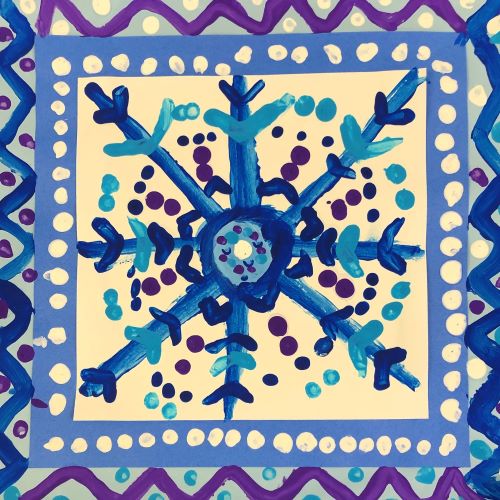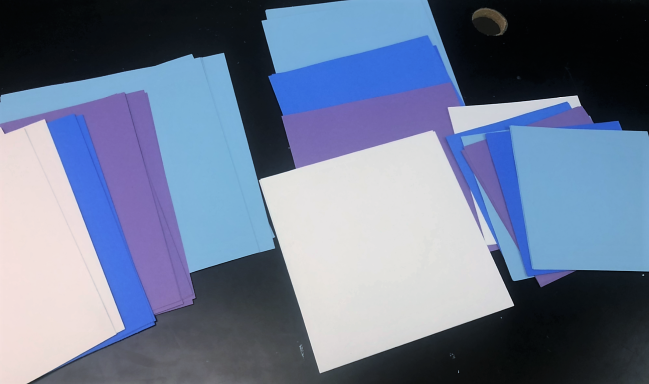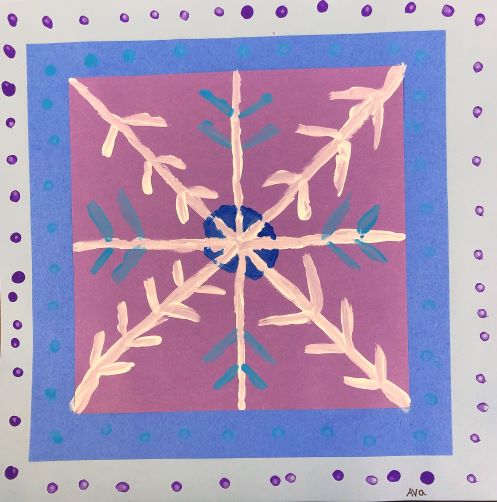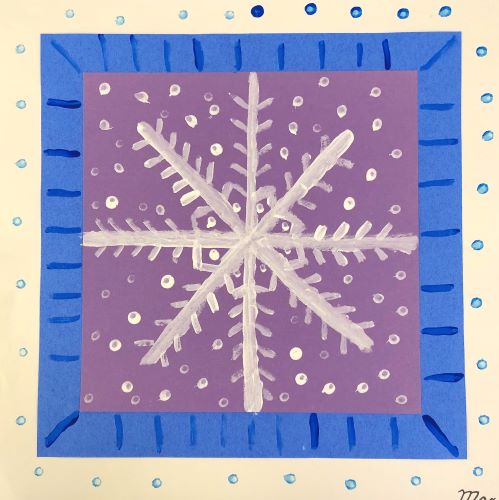
Unique as a snowflake, these beautiful designs connect math and art in a cool way. This project covers Common Core Standards for Science and Math for grades 4 which can be found at the end of the lesson.
Grade Level
3rd, 4th and 5th grades. This project was created by 4th grade students.
Objective for Radial Snowflake Art
Elementary aged students will create radial designs using line and pattern resembling a winter snowflake.
Time
2 – 30 min lessons
Materials
- Dark Blue paper – PACON PAC7307 SunWorks Construction Paper, 12″ x 18″, Dark Blue, 50 Sheets
- Light Blue paper – PACON – 103063 Pacon Tru-Ray Construction Paper, 12-Inches by 18-Inches, 50-Count, Sky Blue (103048)
- Purple (violet) paper – Pacon Tru-Ray Heavyweight Construction Paper, Violet, 12″ x 18″, 50 Sheets – PAC103041
- White construction paper – Tru-Ray Heavyweight Construction Paper, White, 12″ x 18″, 50 Sheets
- Brushes – Acrylic Paint Brush Set, 1 Packs / 10 pcs Nylon Hair Brushes for All Purpose Oil Watercolor Painting Artist Professional Kits
- Glue sticks
- Acrylic paint (Blue, light blue, and violet) – Acrylic Paint Value Set by Craft Smart Bright
- Acrylic paint (white) – DecoArt DA-01 Americana Acrylic Paint, 2-Ounce, Titanium, 2 Oz, Snow White
- Q-tips
Inspiration/Artist
I made this project from linesdotsanddoodles: Click Here
Instruction with Questions
First
Introduce the Element of Art – Line.

Show them some videos about the Element of Art – Line.
* The Lines Song | Art Songs | Scratch Garden
* Line defined – From Goodbye-Art Academy: https://www.youtube.com/watch?v=7hNq-atocIc&list=PLQKLR8OmizLZP6NNt45Be_oG3pH5OahuE&index=37&t=0s
* Elements of Art: Line | KQED Arts
And the Principles of Design – Pattern and Proportion


Then teach them about Radial Design.

This next video is a must! A fabulous art support. You only need to show the first 5 minutes before it goes into explaining another radial art project. Radial Symmetry: Let’s Make a Design! – Click Here
Second
Learn about snowflakes!
Where Do Snowflakes Come From? – Click Here
For reference, give them this handout with examples of snowflakes. I have them practice making several types before making the final one with paint. This is a good activity to have them do while you pull them aside to choose their paper color combinations.

Third
Cut three sizes from all four colors of paper. 12×12, 10×10 and 8×8.

Before assembly, ask students to fold the smallest square in half and then in half again (or do this for them between classes). Then, students glue the three squares together, add their name and allow to dry. Notice how you can see the fold in the example below on the right.


Fourth
Prepare several plates of a variety of blue, light blue, white and purple paint. Along with brushes, I also provide Q-tips for easy polka-dots. While a traditional snowflake has six points, I give them creative license to have eight. Using the folded line, students are able to easily find the straight lines for their snowflake points.

Check out these finished Radial Snowflake art pieces!
















Common Core Standards for Radial Snowflake Art
Grade 3 – Science
Physical Sciences
- Energy and matter have multiple forms and can be changed from one form to another.
e. Students know matter has three forms: solid, liquid, and gas.
f. Students know evaporation and melting are changes that occur when the objects
are heated.
g. Students know that when two or more substances are combined, a new substance may be formed with properties that are different from those of the original materials.
h. Students know all matter is made of small particles called atoms, too small to see with the naked eye.
Grade 4 – Science
Earth Sciences
5. Waves, wind, water, and ice shape and reshape Earth’s land surface.
b. Students know natural processes, including freezing and thawing and the growth of roots, cause rocks to break down into smaller pieces.
c. Students know moving water erodes landforms, reshaping the land by taking it away from some places and depositing it as pebbles, sand, silt, and mud in other places (weathering, transport, and deposition).
Grade 5 – Science
Physical Sciences
a. Students know that during chemical reactions the atoms in the reactants rearrange to form products with different properties.
b. Students know all matter is made of atoms, which may combine to form molecules.
e. Students know scientists have developed instruments that can create discrete images of atoms and molecules that show that the atoms and molecules often occur in well-ordered arrays.
f. Students know differences in chemical and physical properties of substances are used to separate mixtures and identify compounds.
g. Students know properties of solid, liquid, and gaseous substances, such as sugar (C6H O6), water (H2O), helium (He), oxygen (O2), nitrogen (N2), and carbon 12 dioxide (CO2).
Earth Sciences
3. Water on Earth moves between the oceans and land through the processes of evaporation and condensation.
b. Students know when liquid water evaporates, it turns into water vapor in the air and can reappear as a liquid when cooled or as a solid if cooled below the freezing point of water.
c. Students know water vapor in the air moves from one place to another and can form fog or clouds, which are tiny droplets of water or ice, and can fall to Earth as rain, hail, sleet, or snow.
Grade 3 – Math
Operations and Algebraic Thinking
Represent and solve problems involving multiplication and division.
- Interpret products of whole numbers, e.g., interpret 5 × 7 as the total number of objects in 5 groups of 7 objects each.
- Interpret whole-number quotients of whole numbers
- Use multiplication and division within 100 to solve word problems in situations involving equal groups, arrays, and measurement quantities.
Number and Operations—Fractions
Develop understanding of fractions as numbers.
1. Understand a fraction 1/b as the quantity formed by 1 part when a whole is partitioned into b equal parts; understand a fraction a/b as the quantity formed by a parts of size 1/b.
3. Explain equivalence of fractions in special cases, and compare fractions by reasoning about their size.
a. Understand two fractions as equivalent (equal) if they are the same size, or the same point on a number line.
b. Recognize and generate simple equivalent fractions.
Measurement and Data
Geometric measurement: recognize perimeter as an attribute of plane figures and distinguish between linear
and area measures.
- Solve real-world and mathematical problems involving perimeters of polygons, including finding the perimeter given the side
lengths, finding an unknown side length, and exhibiting rectangles with the same perimeter and different areas or with the
same area and different perimeters.
Geometry
Reason with shapes and their attributes
2. Partition shapes into parts with equal areas. Express the area of each part as a unit fraction of the whole.
Grade 4 – Math
Measurement and Data
Geometric measurement: understand concepts of angle and measure angles.
- Recognize angles as geometric shapes that are formed wherever two rays share a common endpoint, and understand concepts of angle measurement:
a. An angle is measured with reference to a circle with its center at the common endpoint of the rays, by considering the fraction of the circular arc between the points where the two rays intersect the circle. An angle that turns through 1/360 of a circle is called a “one-degree angle,” and can be used to measure angles.
b. An angle that turns through n one-degree angles is said to have an angle measure of n degrees. - Measure angles in whole-number degrees using a protractor. Sketch angles of specified measure.
- Recognize angle measure as additive. When an angle is decomposed into non-overlapping parts, the angle measure of the whole is the sum of the angle measures of the parts. Solve addition and subtraction problems to find unknown angles on a diagram in real-world and mathematical problems.
Geometry
Draw and identify lines and angles, and classify shapes by properties of their lines and angles.
- Draw points, lines, line segments, rays, angles (right, acute, obtuse), and perpendicular and parallel lines. Identify these in two-dimensional figures.
- Classify two-dimensional figures based on the presence or absence of parallel or perpendicular lines, or the presence or absence of angles of a specified size. Recognize right triangles as a category, and identify right triangles. (Two-dimensional shapes should include special triangles, e.g., equilateral, isosceles, scalene, and special quadrilaterals, e.g., rhombus, square, rectangle, parallelogram, trapezoid.)
- Recognize a line of symmetry for a two-dimensional figure as a line across the figure such that the figure can be folded
along the line into matching parts. Identify line-symmetric figures and draw lines of symmetry.
Grade 5 – Math
Geometry
Graph points on the coordinate plane to solve real-world and mathematical problems.
- Use a pair of perpendicular number lines, called axes, to define a coordinate system, with the intersection of the lines (the origin) arranged to coincide with the 0 on each line and a given point in the plane located by using an ordered pair of numbers, called its coordinates. Understand that the first number indicates how far to travel from the origin in the direction of one axis, and the second number indicates how far to travel in the direction of the second axis, with the convention that the names of the two axes and the coordinates correspond.
- Represent real-world and mathematical problems by graphing points in the first quadrant of the coordinate plane, and interpret coordinate values of points in the context of the situation.

These are beautiful but the snowflakes all have 8 lines/sides instead of 6. Snowflakes have 6 sides because they are formed by water molecules. The objective also says they will draw a cardinal. I love this idea though and will adapt it for a project. There is quite a bit of information here .
I really appreciate you reaching out. I made an update to the objective. Thanks for catching that! I totally agree that scientifically, snowflakes are only six points. Since this is focused on radial design and line and pattern, I just made a winter art piece out of it. It would be great to show the students that you are taking artistic license, but show them how real snowflakes are made. I would love to see your adaption!